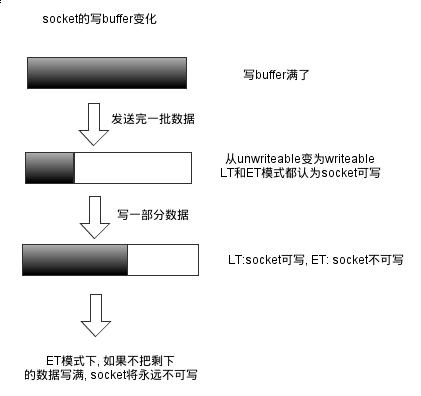http://www.jianshu.com/p/0d497fe5484a#
前言
Java NIO 由以下几个核心部分组成:
- Buffer
- Channel
- Selector
以前基于net包进行socket编程时,accept方法会一直阻塞,直到有客户端请求的到来,并返回socket进行相应的处理。整个过程是流水线的,处理完一个请求,才能去获取并处理后面的请求;当然我们可以把获取socket和处理socket的过程分开,一个线程负责accept,线程池负责处理请求。
NIO为我们提供了更好的解决方案,采用选择器(Selector)找出已经准备好读写的socket,并按顺序处理,基于通道(Channel)和缓冲区(Buffer)来传输和保存数据。
Buffer和Channel已经介绍过深入浅出NIO Channel和Buffer,本文主要介绍NIO的Selector和Socket的实践以及实现原理。
Selector是什么?
在养鸡场,有这一个人,每天的工作就是不停检查几个特殊的鸡笼,如果有鸡进来,有鸡出去,有鸡生蛋,有鸡生病等等,就把相应的情况记录下来。这样,如果负责人想知道鸡场情况,只需要到那个人查询即可,当然前提是,负责得让那个人知道需要记录哪些情况。
Selector的作用相当这个人的工作,每个鸡笼相当于一个SocketChannel,单个线程通过Selector可以管理多个SocketChannel。

为了实现Selector管理多个SocketChannel,必须将多个具体的SocketChannel对象注册到Selector对象,并声明需要监听的事件,目前有4种类型的事件:
connect:客户端连接服务端事件,对应值为SelectionKey.OP_CONNECT(8)
accept:服务端接收客户端连接事件,对应值为SelectionKey.OP_ACCEPT(16)
read:读事件,对应值为SelectionKey.OP_READ(1)
write:写事件,对应值为SelectionKey.OP_WRITE(4)
当SocketChannel有对应的事件发生时,Selector能够觉察到并进行相应的处理。
为了更好地理解NIO Socket,先来看一段服务端的示例代码
ServerSocketChannel serverChannel = ServerSocketChannel.open(); serverChannel.configureBlocking(false); serverChannel.socket().bind(new InetSocketAddress(port)); Selector selector = Selector.open(); serverChannel.register(selector, SelectionKey.OP_ACCEPT); while(true){ int n = selector.select(); if (n == 0) continue; Iterator ite = this.selector.selectedKeys().iterator(); while(ite.hasNext()){ SelectionKey key = (SelectionKey)ite.next(); if (key.isAcceptable()){ SocketChannel clntChan = ((ServerSocketChannel) key.channel()).accept(); clntChan.configureBlocking(false); //将选择器注册到连接到的客户端信道, //并指定该信道key值的属性为OP_READ, //同时为该信道指定关联的附件 clntChan.register(key.selector(), SelectionKey.OP_READ, ByteBuffer.allocate(bufSize)); } if (key.isReadable()){ handleRead(key); } if (key.isWritable() && key.isValid()){ handleWrite(key); } if (key.isConnectable()){ System.out.println("isConnectable = true"); } ite.remove(); } }
服务端连接过程
1、创建ServerSocketChannel实例serverSocketChannel,并bind到指定端口。
2、创建Selector实例selector;
3、将serverSocketChannel注册到selector,并指定事件OP_ACCEPT。
4、while循环执行:
4.1、调用select方法,该方法会阻塞等待,直到有一个或多个通道准备好了I/O操作或等待超时。
4.2、获取选取的键列表;
4.3、循环键集中的每个键:
4.3.a、获取通道,并从键中获取附件(如果添加了附件);
4.3.b、确定准备就绪的操纵并执行,如果是accept操作,将接收的信道设置为非阻塞模式,并注册到选择器;
4.3.c、如果需要,修改键的兴趣操作集;
4.3.d、从已选键集中移除键
在步骤3中,selector只注册了serverSocketChannel的OP_ACCEPT事件
- 如果有客户端A连接服务,执行select方法时,可以通过serverSocketChannel获取客户端A的socketChannel,并在selector上注册socketChannel的OP_READ事件。
- 如果客户端A发送数据,会触发read事件,这样下次轮询调用select方法时,就能通过socketChannel读取数据,同时在selector上注册该socketChannel的OP_WRITE事件,实现服务器往客户端写数据。
NIO Socket实现原理
SocketChannel、ServerSocketChannel和Selector的实例初始化都通过SelectorProvider类实现,其中Selector是整个NIO Socket的核心实现。
public static SelectorProvider provider() { synchronized (lock) { if (provider != null) return provider; return AccessController.doPrivileged( new PrivilegedAction<SelectorProvider>() { public SelectorProvider run() { if (loadProviderFromProperty()) return provider; if (loadProviderAsService()) return provider; provider = sun.nio.ch.DefaultSelectorProvider.create(); return provider; } }); } }
SelectorProvider在windows和linux下有不同的实现,provider方法会返回对应的实现。
Selector分析
Selector是如何做到同时管理多个socket?
Selector初始化时,会实例化PollWrapper、SelectionKeyImpl数组和Pipe。
WindowsSelectorImpl(SelectorProvider sp) throws IOException { super(sp); pollWrapper = new PollArrayWrapper(INIT_CAP); wakeupPipe = Pipe.open(); wakeupSourceFd = ((SelChImpl)wakeupPipe.source()).getFDVal(); // Disable the Nagle algorithm so that the wakeup is more immediate SinkChannelImpl sink = (SinkChannelImpl)wakeupPipe.sink(); (sink.sc).socket().setTcpNoDelay(true); wakeupSinkFd = ((SelChImpl)sink).getFDVal(); pollWrapper.addWakeupSocket(wakeupSourceFd, 0); }
pollWrapper用Unsafe类申请一块物理内存,存放注册时的socket句柄fdVal和event的数据结构pollfd,其中pollfd共8位,0~3位保存socket句柄,4~7位保存event。(答案)


pollWrapper提供了fdVal和event数据的相应操作,如添加操作通过Unsafe的putInt和putShort实现。
void putDescriptor(int i, int fd) { pollArray.putInt(SIZE_POLLFD * i + FD_OFFSET, fd); } void putEventOps(int i, int event) { pollArray.putShort(SIZE_POLLFD * i + EVENT_OFFSET, (short)event); }
SelectionKeyImpl保存注册时的channel、selector、event以及保存在pollWrapper的偏移位置index。
先看看serverChannel.register(selector, SelectionKey.OP_ACCEPT)是如何实现的:
public final SelectionKey register(Selector sel, int ops, Object att) throws ClosedChannelException { synchronized (regLock) { SelectionKey k = findKey(sel); if (k != null) { k.interestOps(ops); k.attach(att); } if (k == null) { // New registration synchronized (keyLock) { if (!isOpen()) throw new ClosedChannelException(); k = ((AbstractSelector)sel).register(this, ops, att); addKey(k); } } return k; } }
- 如果该channel和selector已经注册过,则直接添加事件和附件。
- 否则通过selector实现注册过程。
protected final SelectionKey register(AbstractSelectableChannel ch, int ops, Object attachment) { if (!(ch instanceof SelChImpl)) throw new IllegalSelectorException(); SelectionKeyImpl k = new SelectionKeyImpl((SelChImpl)ch, this); k.attach(attachment); synchronized (publicKeys) { implRegister(k); } k.interestOps(ops); return k; } protected void implRegister(SelectionKeyImpl ski) { synchronized (closeLock) { if (pollWrapper == null) throw new ClosedSelectorException(); growIfNeeded(); channelArray[totalChannels] = ski; ski.setIndex(totalChannels); fdMap.put(ski); keys.add(ski); pollWrapper.addEntry(totalChannels, ski); totalChannels++; } }
传统的事件监听几乎都是通过保存监听关系的方式实现的。
pollWrapper.addEntry(totalChannels, ski);
- 以当前channel和selector为参数,初始化 SelectionKeyImpl 对象selectionKeyImpl ,并添加附件attachment。
- 如果当前channel的数量totalChannels等于SelectionKeyImpl数组大小,对SelectionKeyImpl数组和pollWrapper进行扩容操作。
- 如果totalChannels % MAX_SELECTABLE_FDS == 0,则多开一个线程处理selector。
- pollWrapper.addEntry将把selectionKeyImpl中的socket句柄添加到对应的pollfd。
- k.interestOps(ops)方法最终也会把event添加到对应的pollfd。
所以,不管serverSocketChannel,还是socketChannel,在selector注册事件后,最终都保存在pollArray中。
(那么是通过遍历的方式来传递事件的吗?)接着,再来看看selector中的select是如何实现一次获取多个有事件发生的channel的。
底层由selector实现类的doSelect方法实现,如下:
protected int doSelect(long timeout) throws IOException { if (channelArray == null) throw new ClosedSelectorException(); this.timeout = timeout; // set selector timeout processDeregisterQueue(); if (interruptTriggered) { resetWakeupSocket(); return 0; } // Calculate number of helper threads needed for poll. If necessary // threads are created here and start waiting on startLock adjustThreadsCount(); finishLock.reset(); // reset finishLock // Wakeup helper threads, waiting on startLock, so they start polling. // Redundant threads will exit here after wakeup. startLock.startThreads(); // do polling in the main thread. Main thread is responsible for // first MAX_SELECTABLE_FDS entries in pollArray. try { begin(); try { subSelector.poll(); } catch (IOException e) { finishLock.setException(e); // Save this exception } // Main thread is out of poll(). Wakeup others and wait for them if (threads.size() > 0) finishLock.waitForHelperThreads(); } finally { end(); } // Done with poll(). Set wakeupSocket to nonsignaled for the next run. finishLock.checkForException(); processDeregisterQueue(); int updated = updateSelectedKeys(); // Done with poll(). Set wakeupSocket to nonsignaled for the next run. resetWakeupSocket(); return updated; }
其中 subSelector.poll() 是select的核心,由native函数poll0实现(可参考c代码),readFds、writeFds 和exceptFds数组用来保存底层select的结果,数组的第一个位置都是存放发生事件的socket的总数,其余位置存放发生事件的socket句柄fd。
private final int[] readFds = new int [MAX_SELECTABLE_FDS + 1]; private final int[] writeFds = new int [MAX_SELECTABLE_FDS + 1]; private final int[] exceptFds = new int [MAX_SELECTABLE_FDS + 1]; private int poll() throws IOException{ // poll for the main thread return poll0(pollWrapper.pollArrayAddress, Math.min(totalChannels, MAX_SELECTABLE_FDS), readFds, writeFds, exceptFds, timeout); }
执行 selector.select() ,poll0函数把指向socket句柄和事件的内存地址传给底层函数。
- 如果之前没有发生事件,程序就阻塞在select处,当然不会一直阻塞,因为epoll在timeout时间内如果没有事件,也会返回。
- 一旦有对应的事件发生,poll0方法就会返回。
- processDeregisterQueue方法会清理那些已经cancelled的SelectionKey
- updateSelectedKeys方法统计有事件发生的SelectionKey数量,并把符合条件发生事件的SelectionKey添加到selectedKeys哈希表中,提供给后续使用。
在早期的JDK1.4和1.5 update10版本之前,Selector基于select/poll模型实现,是基于IO复用技术的非阻塞IO,不是异步IO。在JDK1.5 update10和linux core2.6以上版本,sun优化了Selctor的实现,底层使用epoll替换了select/poll。
epoll原理
epoll是Linux下的一种IO多路复用技术,可以非常高效的处理数以百万计的socket句柄。(对于nio的底层学习最终还是学习epoll原理)
http://blog.csdn.net/coder_yi_liu/article/details/8938927
先看看使用c封装的3个epoll系统调用:
- int epoll_create(int size)
epoll_create建立一个epoll对象。参数size是内核保证能够正确处理的最大句柄数,多于这个最大数时内核可不保证效果。 -
int epoll_ctl(int epfd, int op, int fd, struct epoll_event *event)
epoll_ctl可以操作epoll_create创建的epoll,如将socket句柄加入到epoll中让其监控,或把epoll正在监控的某个socket句柄移出epoll。 -
int epoll_wait(int epfd, struct epoll_event *events,int maxevents, int timeout)
epoll_wait在调用时,在给定的timeout时间内,所监控的句柄中有事件发生时,就返回用户态的进程。
大概看看epoll内部是怎么实现的:
- epoll初始化时,会向内核注册一个文件系统,用于存储被监控的句柄文件,调用epoll_create时,会在这个文件系统中创建一个file节点。同时epoll会开辟自己的内核高速缓存区,以红黑树的结构保存句柄,以支持快速的查找、插入、删除。还会再建立一个list链表,用于存储准备就绪的事件。
- 当执行epoll_ctl时,除了把socket句柄放到epoll文件系统里file对象对应的红黑树上之外,还会给内核中断处理程序注册一个回调函数,告诉内核,如果这个句柄的中断到了,就把它放到准备就绪list链表里。所以,当一个socket上有数据到了,内核在把网卡上的数据copy到内核中后,就把socket插入到就绪链表里。
- 当epoll_wait调用时,仅仅观察就绪链表里有没有数据,如果有数据就返回,否则就sleep,超时时立刻返回。
epoll的两种工作模式:
- LT:level-trigger,水平触发模式,只要某个socket处于readable/writable状态,无论什么时候进行epoll_wait都会返回该socket。
- ET:edge-trigger,边缘触发模式,只有某个socket从unreadable变为readable或从unwritable变为writable时,epoll_wait才会返回该socket。
socket读数据

socket写数据

read实现
通过遍历selector中的SelectionKeyImpl数组,获取发生事件的socketChannel对象,其中保存了对应的socket句柄,实现如下。
public int read(ByteBuffer buf) throws IOException { if (buf == null) throw new NullPointerException(); synchronized (readLock) { if (!ensureReadOpen()) return -1; int n = 0; try { begin(); synchronized (stateLock) { if (!isOpen()) { return 0; } readerThread = NativeThread.current(); } for (;;) { n = IOUtil.read(fd, buf, -1, nd); if ((n == IOStatus.INTERRUPTED) && isOpen()) { // The system call was interrupted but the channel // is still open, so retry continue; } return IOStatus.normalize(n); } } finally { readerCleanup(); // Clear reader thread // The end method, which end(n > 0 || (n == IOStatus.UNAVAILABLE)); // Extra case for socket channels: Asynchronous shutdown // synchronized (stateLock) { if ((n <= 0) && (!isInputOpen)) return IOStatus.EOF; } assert IOStatus.check(n); } } }
通过Buffer的方式读取socket的数据。
wakeup实现
public Selector wakeup() {
synchronized (interruptLock) {
if (!interruptTriggered) {
setWakeupSocket();
interruptTriggered = true;
}
}
return this;
}
// Sets Windows wakeup socket to a signaled state.
private void setWakeupSocket() {
setWakeupSocket0(wakeupSinkFd);
}
private native void setWakeupSocket0(int wakeupSinkFd);
最终调用了native方法来实现。看来wakeupSinkFd这个变量是为wakeup方法使用的。
其中interruptTriggered为中断已触发标志,当pollWrapper.interrupt()之后,该标志即为true了;因为这个标志,连续两次wakeup,只会有一次效果。
为了实现client和server的数据交互,Linux下采用管道pipe实现,windows下采用两个socket之间的通信进行实现,它们都有这样的特性:
- 都有两个端,一个 是read端,一个是write端,windows中两个socket也是read和write的角色。
- 当往write端写入 数据,则read端即可以收到数据。